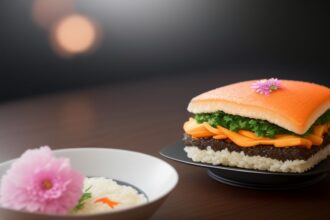Over the past few decades, Thai cuisine has experienced a meteoric rise in popularity around the world. The unique flavors, fragrant herbs, and vibrant colors of Thai dishes have captured the hearts and taste buds of food lovers everywhere. From humble beginnings as a regional cuisine to its current status as a global culinary destination, the journey of Thai cuisine has been nothing short of remarkable. In this article, we will explore the factors that have contributed to the rise of Thai cuisine and how Thailand has become a culinary powerhouse on the world stage.
1. The Origins of Thai Cuisine
Thai cuisine has its roots in the diverse culinary traditions of Thailand’s various regions. Influenced by neighboring countries such as China, India, and Vietnam, as well as the indigenous ingredients and cooking techniques of the Thai people, the cuisine has evolved over centuries to become the vibrant and flavorful cuisine that it is today.
2. The Role of Ingredients
One of the key factors that have contributed to the popularity of Thai cuisine is the use of fresh and fragrant ingredients. Thai dishes are known for their bold flavors, which come from a combination of herbs and spices such as lemongrass, galangal, kaffir lime leaves, and Thai chilies. These ingredients give Thai dishes their distinctive taste and aroma that sets them apart from other cuisines.
3. The Importance of Balance
Another defining feature of Thai cuisine is the importance of achieving a balance of flavors – sweet, sour, salty, spicy, and bitter. This balance is achieved through the careful selection and combination of ingredients, as well as the skillful use of seasonings and sauces. This harmonious blend of flavors is what makes Thai dishes so appealing to a wide range of palates.
4. The Influence of Thai Street Food
Street food has long been a part of Thai culinary culture, with street vendors selling a wide variety of dishes from carts and stalls across the country. The popularity of Thai street food has helped to introduce Thai cuisine to a global audience, as travelers and food enthusiasts seek out authentic and affordable dishes on the streets of Bangkok and other cities.
5. The Rise of Thai Restaurants
The proliferation of Thai restaurants around the world has also played a significant role in the rise of Thai cuisine. From upscale fine dining establishments to casual neighborhood eateries, Thai restaurants offer diners the opportunity to experience the authentic flavors of Thailand in a variety of settings. This accessibility has helped to introduce Thai cuisine to a wider audience and create a demand for more diverse and innovative dishes.
6. The Influence of Thai Chefs
The success of Thai cuisine on the global stage can also be attributed to the talent and creativity of Thai chefs. Chefs such as David Thompson, whose Michelin-starred restaurant Nahm in Bangkok has garnered international acclaim, have raised the profile of Thai cuisine and inspired a new generation of chefs to explore and experiment with Thai flavors and techniques.
7. The Role of Tourism
Thailand’s booming tourism industry has also played a significant role in the rise of Thai cuisine. As more and more travelers visit Thailand to experience its rich culture, history, and natural beauty, they are also discovering the delights of Thai cuisine. The proliferation of cooking classes, food tours, and culinary festivals has helped to promote Thai cuisine as a key part of the country’s cultural heritage.
8. Thai Cuisine in the Media
The media has also played a crucial role in promoting Thai cuisine to a global audience. From television shows and cooking competitions to food blogs and social media influencers, the visibility of Thai cuisine in popular culture has helped to generate interest and excitement around Thai dishes. This increased exposure has helped to establish Thailand as a global culinary destination and a must-visit destination for food lovers.
9. The Rise of Thai Ingredients
As the popularity of Thai cuisine has grown, so too has the demand for authentic Thai ingredients. Thai staples such as fish sauce, coconut milk, and curry pastes are now readily available in supermarkets around the world, making it easier for home cooks to recreate their favorite Thai dishes. The availability of these ingredients has also inspired chefs to explore new ways of using them in fusion dishes and innovative recipes.
10. Thai Cuisine Goes Global
The rise of Thai cuisine has also been fueled by the globalization of food trends. As people become more adventurous in their culinary tastes and seek out new and exotic flavors, Thai cuisine has emerged as a favorite choice for those looking to explore the diverse and vibrant flavors of Southeast Asia. From traditional dishes such as pad Thai and green curry to modern interpretations and fusion dishes, Thai cuisine continues to captivate and inspire food lovers around the world.
11. The Future of Thai Cuisine
As Thai cuisine continues to gain popularity and recognition on the global stage, the future looks bright for Thailand’s culinary scene. With an abundance of talented chefs, a rich culinary heritage, and a commitment to preserving and sharing traditional recipes and techniques, Thai cuisine is poised to remain a top global culinary destination for years to come.
12. Thai Cuisine and Sustainability
In recent years, there has been a growing emphasis on sustainability and ethical sourcing in the food industry. This trend has also had an impact on Thai cuisine, with a focus on using locally sourced and organic ingredients, supporting small-scale producers, and promoting sustainable fishing and farming practices. By embracing these principles, Thai cuisine is not only delicious but also environmentally friendly and socially responsible.
13. Thai Cuisine and Health
In addition to its delicious flavors and vibrant colors, Thai cuisine is also known for its health benefits. Many Thai dishes are packed with fresh vegetables, herbs, and lean proteins, making them a nutritious and balanced choice for those looking to eat well. The use of herbs and spices in Thai cooking also has medicinal properties, promoting digestion, boosting immunity, and reducing inflammation. With a focus on fresh, natural ingredients and balanced flavors, Thai cuisine offers a delicious way to eat well and stay healthy.
14. The Spread of Thai Cuisine
As Thai cuisine continues to gain popularity around the world, the spread of Thai restaurants and culinary experiences shows no signs of slowing down. From traditional Thai eateries to modern fusion restaurants, the diverse and delicious flavors of Thai cuisine are now enjoyed by people of all backgrounds and nationalities. Whether you’re craving a fiery curry, a refreshing salad, or a comforting bowl of noodles, Thai cuisine has something to offer for every taste and occasion.
15. Conclusion
In conclusion, the rise of Thai cuisine can be attributed to a combination of factors – from the unique flavors and ingredients of Thai dishes to the talent and creativity of Thai chefs, the influence of Thai street food, the role of tourism, and the media’s promotion of Thai cuisine. As Thailand continues to showcase its culinary heritage and innovation on the global stage, it is clear that Thai cuisine has firmly established itself as a global culinary destination and a beloved choice for food lovers everywhere. Whether you’re a seasoned Thai food aficionado or a newcomer to the delights of Thai cuisine, there has never been a better time to savor the flavors of Thailand and experience the magic of Thai cuisine for yourself.
















